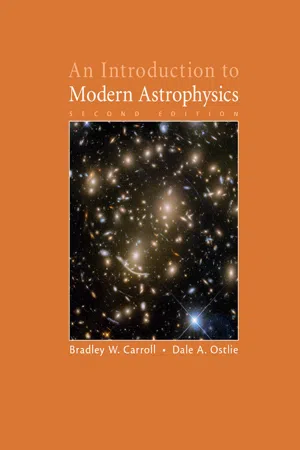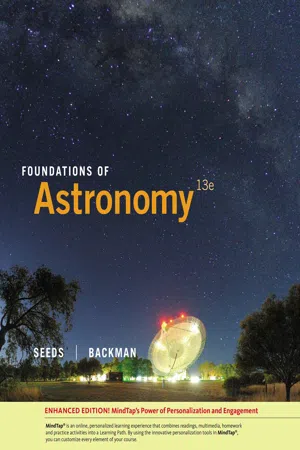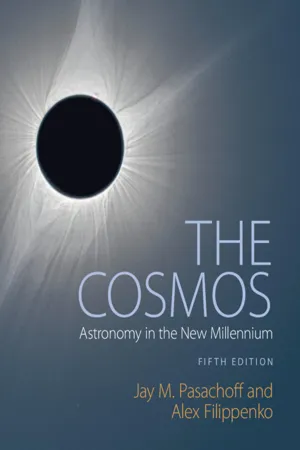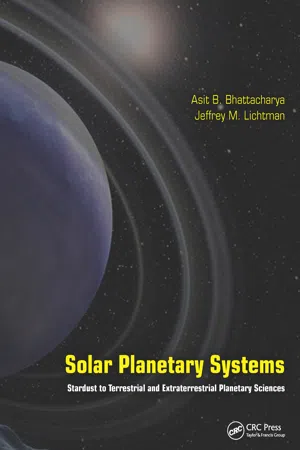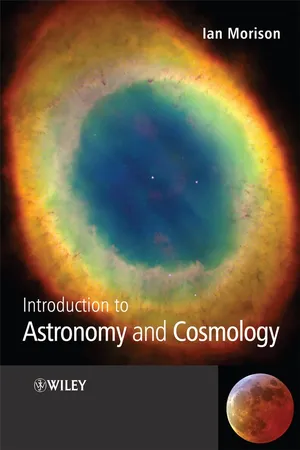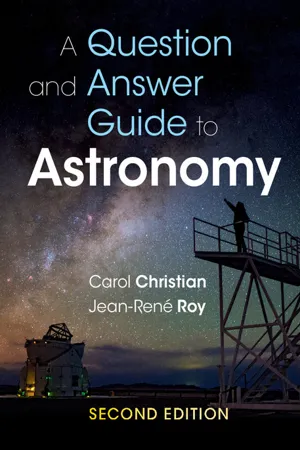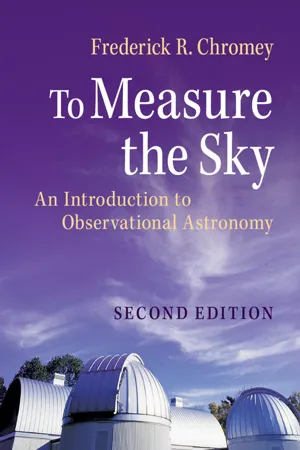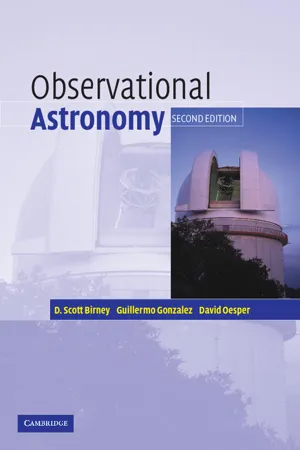Physics
Astronomical Telescopes
Astronomical telescopes are instruments used to observe celestial objects such as stars, planets, and galaxies. They gather and focus light, allowing astronomers to study distant objects and phenomena. There are different types of telescopes, including refracting telescopes that use lenses and reflecting telescopes that use mirrors, each with its own advantages and limitations.
Written by Perlego with AI-assistance
Related key terms
1 of 5
12 Key excerpts on "Astronomical Telescopes"
- eBook - PDF
- Bradley W. Carroll, Dale A. Ostlie(Authors)
- 2017(Publication Date)
- Cambridge University Press(Publisher)
The proper design of a telescope must take into account the principal applications that are intended for the instrument. 6.2 OPTICAL TELESCOPES In the last section we studied some of the fundamental aspects of optics in the context of astronomical observing. We now build on those concepts to consider design features of optical telescopes. Refracting Telescopes The major optical component of a refracting telescope is the primary or objective lens of focal length f obj . The purpose of the objective lens is to collect as much light as possible and with the greatest possible resolution, bringing the light to a focus at the focal plane. A photographic plate or other detector may be placed at the focal plane to record the image, or the image may be viewed with an eyepiece, which serves as a magnifying glass. The eyepiece would be placed at a distance from the focal plane equal to its focal length, f eye , causing the light rays to be refocused at infinity. Figure 6.15 shows the path of rays coming from a point source lying off the optical axis at an angle θ . The rays ultimately emerge from the eyepiece at an angle φ from the optical axis. The angular magnification produced by this arrangement of lenses can be shown to be (Problem 6.5) m = f obj f eye . (6.9) Clearly, eyepieces of different focal lengths can produce different angular magnifications. Viewing a large image requires a long objective focal length, in combination with a short focal length for the eyepiece. Recall, however, that the illumination decreases with the square of the objective’s focal length (Eq. 6.8). To compensate for the diminished illumination, a larger-diameter objective is needed. Unfortunately, significant practical limitations exist for the size of the objective 6.2 Optical Telescopes 155 f obj f eye FIGURE 6.15 A refracting telescope is composed of an objective lens and an eyepiece. - eBook - PDF
- Michael Seeds, Dana Backman(Authors)
- 2016(Publication Date)
- Cengage Learning EMEA(Publisher)
NASA/ESA/STScI Copyright 2017 Cengage Learning. All Rights Reserved. May not be copied, scanned, or duplicated, in whole or in part. Due to electronic rights, some third party content may be suppressed from the eBook and/or eChapter(s). Editorial review has deemed that any suppressed content does not materially affect the overall learning experience. Cengage Learning reserves the right to remove additional content at any time if subsequent rights restrictions require it. 113 Chapter 6 LIGHT AND TELESCOPES astronomers have solved these problems in a number of ways. Look at Modern Optical Telescopes on pages 114–115 and notice three important points about telescope design and ten new terms that describe optical telescopes and their operation: 1 Conventional-design reflecting tele-scopes use large, solid, heavy mirrors to focus starlight to a prime focus, or by using a secondary mirror, to a Cassegrain focus (pronounced KASS-uh-grain ). Other telescopes have a Newtonian focus or a Schmidt-Cassegrain focus. 2 Telescopes must have a sidereal drive to follow the stars. An equatorial mount with motion around a polar axis is the conventional way to provide that 1 2 Radio astronomers face a problem of radio interference comparable to visible light pollution. Weak radio waves from the cosmos are easily drowned out by human-made radio noise— everything from automobiles with faulty spark plugs to poorly designed communication systems. A few narrow radio bands are reserved for astronomy research, but even those are often con-taminated by stray signals. To avoid that noise and have the radio equivalent of a dark sky, astronomers locate radio tele-scopes as far from civilization as possible. Hidden in mountain valleys or in remote deserts, they are able to study the Universe protected from humanity’s radio output. As you have already learned, astronomers prefer to put optical telescopes on high mountains for several reasons. - eBook - ePub
- James B Kaler(Author)
- 2016(Publication Date)
- WSPC(Publisher)
First, they make stars, planets, etc. brighter by gathering more light than the eye can possibly do alone. Simply put, a telescope is a light bucket that collects starlight with lenses or mirrors and brings it to a focus for the observer to see directly or to record permanently. We can thus see ever-fainter stars, asteroids, galaxies, whatever, just by making the lens or mirror bigger. Telescopes also magnify, making the scene look larger, as can be attested to by anybody who has used binoculars (twin aligned telescopes) at a racetrack or for that matter anywhere else. To the astronomer, magnification refers to the ability to see or resolve fine detail that the eye alone cannot discern. What Astronomical Telescopes do NOT do is cut the light-travel time from a star or other object to here.The past four centuries since Galileo, and especially the last few decades, have seen a stunning increase in our ability to know the heavens, to probe deeply and with increasing detail into the cosmos. Aided by sensitive detectors, powerful computers, and larger telescopes, we can scan the sky nightly to accumulate so much data that we store it for future generations to mine, so extraordinarily much that data management has become an astronomical specialty. Moreover, we have expanded the concept of “telescope” to cover observation of the entire electromagnetic spectrum, from long wave radio to high energy gamma rays, and of necessity have taken our telescopes into space in order to free us from the blurring and absorptive effects of the Earth’s atmosphere, which blocks much of the electromagnetic spectrum. So here we look at the traditional tools of astronomy and at how we gather the data through which cosmic understanding (or so we think) might be accomplished. And it all started with Galileo’s tiny lens that helped change the world.Refractors and how telescopes work
There are two different kinds of astronomical telescope used in the optical domain, refractors and reflectors, with many variations on the themes. Refractors use lenses, reflectors rather obviously mirrors. Since the refractor is the more familiar of the two, we’ll use it as an example to outline basic properties of telescopes in general. Like Galileo’s, the refractor uses a curved, convex lens (one bowed outward in the middle) called the objective. Stars and the like are so far away that their incoming light rays (or photons) run parallel to one another. The lens’s purpose is to gather the incoming parallel beams of light and converge them toward a focus where they meet. The distance from the objective to the focal point is the focal length, which depends on the curvature of the objective. If you put a screen at the focus perpendicular to the lens’s axis (the focal plane), you’ll see a projected image of the source, be it a field of stars, a planet, or perhaps a distant bird, which will appear inverted, up for down, and left for right. - eBook - PDF
- Andrew Fraknoi, David Morrison, Sidney C. Wolff(Authors)
- 2016(Publication Date)
- Openstax(Publisher)
Chapter Outline 6.1 Telescopes 6.2 Telescopes Today 6.3 Visible-Light Detectors and Instruments 6.4 Radio Telescopes 6.5 Observations outside Earth’s Atmosphere 6.6 The Future of Large Telescopes Thinking Ahead If you look at the sky when you are far away from city lights, there seem to be an overwhelming number of stars up there. In reality, only about 9000 stars are visible to the unaided eye (from both hemispheres of our planet). The light from most stars is so weak that by the time it reaches Earth, it cannot be detected by the human eye. How can we learn about the vast majority of objects in the universe that our unaided eyes simply cannot see? In this chapter, we describe the tools astronomers use to extend their vision into space. We have learned almost everything we know about the universe from studying electromagnetic radiation, as discussed in the chapter on Radiation and Spectra. In the twentieth century, our exploration of space made it possible to detect electromagnetic radiation at all wavelengths, from gamma rays to radio waves. The different wavelengths carry different kinds of information, and the appearance of any given object often depends on the wavelength at which the observations are made. Figure 6.1 Hubble Space Telescope (HST). This artist’s impression shows the Hubble above Earth, with the rectangular solar panels that provide it with power seen to the left and right. 6 ASTRONOMICAL INSTRUMENTS Chapter 6 Astronomical Instruments 189 6.1 TELESCOPES Learning Objectives By the end of this section, you will be able to: Describe the three basic components of a modern system for measuring astronomical sources Describe the main functions of a telescope Describe the two basic types of visible-light telescopes and how they form images Systems for Measuring Radiation There are three basic components of a modern system for measuring radiation from astronomical sources. - eBook - PDF
- Michael Seeds(Author)
- 2018(Publication Date)
- Cengage Learning EMEA(Publisher)
Modern astronomy has come to depend on observations that cover the entire electromagnetic spectrum. More orbiting space telescopes are planned that will be even more versatile and sensitive than the ones operating now. 6-5 Astronomical Instruments and Techniques Just looking through a telescope doesn’t tell you much. A star looks like a point of light. A planet looks like a little disk. A galaxy looks like a hazy patch. To use a research telescope to learn about the Universe, you need to carefully analyze the light the telescope gathers. Special instruments attached to the tele-scope make that possible. X-rays focused on detector Incoming X-rays Nested metal mirrors ▲ Figure 6-18 X-rays that hit a mirror at grazing angles are reflected like a pebble skipping across a pond. Thus, X-ray telescope mirrors like the ones in Chandra are shaped like barrels rather than dishes. NASA/SAO/CXC Adding liquid nitrogen to the camera on a telescope is a familiar task for astronomers. ▲ Figure 6-19 Astronomical cameras with CCD and other types of array detectors must be cooled to low temperatures to operate properly, and that is especially true for infrared cameras. Kris Koenig/Coast Learning Systems Copyright 2019 Cengage Learning. All Rights Reserved. May not be copied, scanned, or duplicated, in whole or in part. Due to electronic rights, some third party content may be suppressed from the eBook and/or eChapter(s). Editorial review has deemed that any suppressed content does not materially affect the overall learning experience. Cengage Learning reserves the right to remove additional content at any time if subsequent rights restrictions require it. 119 Chapter 6 Light and Telescopes (shortwavelength) light passing through a prism bends the most, and red (long-wavelength) light bends least. Thus, the white light entering the prism is spread into a spectrum exiting the prism ( Figure 6-22 ). - eBook - PDF
The Cosmos
Astronomy in the New Millennium
- Jay M. Pasachoff, Alex Filippenko(Authors)
- 2019(Publication Date)
- Cambridge University Press(Publisher)
41 Everybody knows that astronomers use telescopes, but not every- body realizes that the telescopes astronomers use are of very differ- ent types. Moreover, very few modern telescopes are used directly with the eye. In this chapter, we will first discuss the telescopes that astronomers use to collect visible light, as they have for hundreds of years. Then we will see how astronomers now also use telescopes to study gamma rays, x-rays, ultraviolet, infrared, and radio waves. We will see how the James Webb Space Telescope, at this writing scheduled for launch in 2021, is expected to transform many areas of astronomy. 3.1 THE FIRST TELESCOPES FOR ASTRONOMY Over 400 years ago, a Dutch optician put two eyeglass lenses together, and noticed that distant objects appeared closer (that is, they looked magnified). The next year, in 1609, the English scientist Thomas Harriot built one of these devices and looked at the Moon. But all he saw was a blotchy surface, and he didn’t make anything of it. Credit for first using a telescope to make serious astronomical studies goes to Galileo Galilei. In 1609, Galileo heard that a telescope had been made in Holland, so in Venice he made one of his own and used it to look at the Moon. Perhaps as a result of his training in interpreting light and shadow in drawings (he was surrounded by the Renaissance and its developments in visual perspective), Galileo realized that the light and dark patterns on the Moon meant that there were craters on its surface (■ Fig. 3–1). With his tiny telescopes – using lenses only a few centimeters across and provid- ing, with an eyepiece, a magnification of only 20 or 30, not much more powerful than a modern pair of binoculars and showing a smaller part of the sky– he went on to revolutionize our view of the cosmos, as we will further discuss in Chapter 5. Whenever Galileo looked at Jupiter through his telescope, he saw that it was not just a point of light, but appeared as a small disk. - eBook - PDF
Solar Planetary Systems
Stardust to Terrestrial and Extraterrestrial Planetary Sciences
- Asit B. Bhattacharya, Jeffrey M. Lichtman(Authors)
- 2016(Publication Date)
- CRC Press(Publisher)
Solar telescopes can rely on magnifica-tion mainly as they do not have to look deep into space or gather much light for clearly viewing the Sun. Instrument quality : A research telescope is only as good as the cameras and other instruments which record and analyze the light that it captures. Instruments are judged by factors like the quality of their images, how effectively they spread out light, and how much light they capture. Lower resolution image Higher resolution image FIGURE 19.10 Lower and higher resolution images. 421 The Telescope—The Essential Tool 19.7 NASA’s Great Observatories The four Great Observatories are a series of space telescopes with a purpose to give the complete picture of objects at different wavelengths. Each observatory investigates a par-ticular wavelength region in a greater detail [6–8]. The telescopes, in order of launch, are (1) the Hubble Space Telescope (1990); (2) Compton Gamma Ray Observatory, popularly called CGRO (1991); (3) Chandra X-ray Observatory (1999); and (4) Spitzer Space Telescope (2003). Figure 19.11 shows each telescope including the wavelength region it was built to observe. All except for CGRO are providing informa-tion at present. Figure 19.12 exhibits the images showing the remains of an exploded star (Kepler’s supernova), as seen by three telescopes of the Great Observatories. 19.7.1 Hubble Space Telescope’s Design The Hubble Space Telescope was deployed from the space shuttle Discovery during STS-31 on April 25, 1990. Since then, there have been five servicing missions that contin-ued to upgrade the telescope’s scientific instruments and operational systems. Hubble reached a major milestone, its twentieth anniversary in orbit, on April 24, 2010. - eBook - PDF
- Rudolf Kingslake(Author)
- 2012(Publication Date)
- Academic Press(Publisher)
C H A P T E R 6 Astronomical Telescopes A. B. MEINEL Unversity of Arizona, Tucson, Arizona I. General Specifications 133 A. Atmospheric Limitations 134 B. Optical Specifications 136 II. Optical Configurations 138 A. Prime- or Newtonian-Focus Configurations 138 B. Prime-Focus Wide-Field Correctors 139 C. Cassegrain-Focus Configurations 140 D. Cassegrain Wide-Field Correctors 141 E. Hybrid Configurations 142 F. Catadioptric Configurations 143 G. Coudέ Configurations 143 III. Optical Components 146 A. Vitreous Materials 147 B. Metal Mirrors 149 C. Optical Fabrication 151 D. Mirror Supports 157 E. Optical Testing 158 IV. System Design Choices 161 A. Primary/-Ratio 161 B. Secondary Magnification 162 C. Secondary and Vane Obscuration 163 D. /-Ratio Parameters 163 V. Telescope Mountings 165 A. Equatorial Class 165 B. Alt-Azimuth Class 171 C. Alt-Alt Class 172 D. Hybrid Classes 172 E. Sky Coverage 174 VI. Equatorial Telescope Design 177 A. Telescope Tube 177 B. Drive Worm Wheels 178 C. Pointing Accuracy 179 D. Telescope Drive Rates 179 VII. Coronagraphs 180 I. GENERAL SPECIFICATIONS The design and construction of large telescope systems present one of the major challenges in the field of optical instrumentation. In large tele-scopes, one encounters the requirement of high optical image quality in 133 134 Α. Β. MEINEL structures so large that the flexural deformation of the optical and mechani-cal systems are serious limiting factors. For the past three decades, the frontier of telescope art was defined by the 200-in. Palomar telescope. At this time, it appears likely that another period of advance in the state of the art of telescopes is about to occur. There are plans under way throughout the world for ten telescopes larger than 120-in. aperture, led by the 238-in. telescope of the USSR. It is therefore appropriate at this time to review the problems of large telescope contruction. - eBook - ePub
- Ian Morison(Author)
- 2013(Publication Date)
- Wiley(Publisher)
will see more detail but not significantly more than a telescope whose aperture is ~400 cm across. The best location for an optical telescope is in space, as in the case of the Hubble Space Telescope, where its full resolution of 1/20th of an arcsecond at visible wavelengths may be realised.The turbulence of the atmosphere and hence seeing varies from night to night. In bad seeing the image of a star will appear bloated and the Moon can appear to be boiling! On such nights the image quality will be totally determined by the atmosphere. But, rarely, the atmosphere can be still and then the aperture, type of telescope and the quality of the optics will determine what you can see. The seeing tends to have more effect on large aperture telescopes, so when the seeing is not good a smaller telescope may actually give better views of the planets.5.5 The magnification of a telescope
The objective of a telescope, be it lens or mirror, produces an image in its focal plane. Here a charge-coupled device (CCD) array might be placed to produce an image of the object or the image might be viewed by using an eyepiece. The eyepiece works like a magnifying glass enabling one to view the image in detail. Eyepieces have focal lengths ranging from ~2.5 up to ~55 mm. The magnification of a telescope is simply obtained by dividing the focal length of the objective by the focal length of the eyepiece, so a 12 mm focal length eyepiece coupled with a 1200 mm focal length objective gives a magnification of ×100. It is also possible to place a concave lens in the light path close to the eyepiece. This is referred to as a Barlow lens, and has the effect of diverging the light cone and giving the effect of having an objective of greater focal length, so providing an effective increase in magnification for a given primary focal length. The effective focal length is usually doubled (called ×2 Barlows), but can be obtained with effective magnification ratios of 2.5 or even 4. - eBook - PDF
- Carol Christian, Jean-René Roy(Authors)
- 2017(Publication Date)
- Cambridge University Press(Publisher)
How did the modern observatory evolve? 299 systems that may be located off-site where they can be accessed by the principal investi- gators and, after some proprietary period, by the entire astronomical community. Several observatories have a target-of-opportunity mode where astronomers can submit an observing request for rapid follow up, e.g. in the case of a new supernova or a gamma- ray burst. Observatories with several telescopes on a given site or at different sites are often owned by a consortium of institutions or international organizations, often with some funding from scientific government agencies. The most prominent example is ESO, the European Southern Observatory, the foremost intergovernmental astronomy organisation in Europe, with 15 member states. ESO operates observatories at three sites in Chile. In the USA, the Association of Universities for Research in Astronomy (AURA) is a consor- tium of 40 universities that operates telescopes in Arizona, New Mexico, and Hawai’i in the USA and in Chile. AURA also operates, on behalf of NASA, the Space Telescope Science Institute, the science center of the Hubble Space Telescope, and the James Webb Space Telescope (to be launched in 2018). Surveys of the sky have been greatly enabled by robotic telescopes. Batteries of automated small telescopes are now in operation around the world to photograph the sky every few nights to search for supernovae or other explosive events. Some networks operate telescopes that monitor a large number of stars to detect exoplanets as they pass in front of their parent stars. With these technologies, observational astronomy has been completely transformed over the past three decades. Another important asset of modern astronomy is provided by the huge central repositories of astronomical images and computer-accessible and searchable catalogs. One of the most important and most productive data archives in astronomy is the Barbara A. - eBook - PDF
To Measure the Sky
An Introduction to Observational Astronomy
- Frederick R. Chromey(Author)
- 2016(Publication Date)
- Cambridge University Press(Publisher)
Chapter 6 Astronomical Telescopes The adventure is not to see new things, but to see things with new eyes. – Marcel Proust (1871 – 1922), Remembrance of Things Past , 1927 While I disagree with Proust about the thrill of seeing utterly new things (I ’ m sorry, that is an adventure), if I wonder about seeing things “ with new eyes, ” telescopes immediately come to mind. No instrument has so revolution-ized a science, nor so long and thoroughly dominated its practice, as has the telescope astronomy. No instrument so simple (amateurs still make their own) has produced such a sustained transformation in humanity ’ s understanding of the universe. In this chapter, we examine the basic features of the modern ground-based optical telescope designs. Schroeder ( 1987 ) provides a more advanced treat-ment. We will consider some pronounced advantages, disadvantages, and special requirements that space-based telescopes have compared to their ground-based cousins. Because it is such an important technology for the future of the ground-based telescope, we will take some trouble to understand the principles of adaptive optics, and its potential for removing some of the natural but nasty (for astronomy) consequences of living on a planet with an atmos-phere. Finally, we will look at the kinds of large – and extremely large – ground-based telescopes now under construction. We begin, however, not with the telescope, but with the apparatus that supports and points it. 6.1 Telescope mounts and drives My brother began his series of sweeps when the instrument was yet in a very un fi nished state, and my feelings were not very comfortable when every moment I was alarmed by a crack or fall, knowing him to be elevated fi fteen feet or more on a temporary cross-beam instead of a safe gallery. The ladders had not even their braces at the bottom; and one night, in a very high wind, he had hardly touched the ground when the whole apparatus came down. – Caroline Herschel, Letter, 1784 150 - eBook - PDF
- D. Scott Birney, Guillermo Gonzalez, David Oesper(Authors)
- 2006(Publication Date)
- Cambridge University Press(Publisher)
A compari- son of the basic telescope types is shown in Figure 6.4. The first refractors, beginning with Galileo, were singlets, where the objective consisted of a single converging lens. The next major improve- ments came with the introduction of doublets (two lenses) and then triplets (three lenses), which greatly improved image quality (see below). Because a lens can be supported only on its periphery, it will sag notice- ably at its center if it is made too large. Larger lenses also absorb more Optical telescopes 109 Newtonian Cassegrain Schmidt-Cassegrain Film Schmidt Camera Refractor Maksutov Prime focus Gregorian Figure 6.4. The major types of telescope optical designs. For each diagram, parallel light from a distant object enters from the left. An eyepiece is shown only for the refractor. light, since they must be thicker. For these reasons, the largest refractor ever built is only 40 inches (∼1 m) in diameter (Yerkes Observatory). The first reflecting telescope was a Newtonian design. A Newtonian telescope employs a parabolic shaped objective (primary) mirror and a flat secondary mirror that redirects the light to focus at a place outside the telescope tube and at a right angle with respect to the long axis of the telescope tube (see Figure 6.4). A large class of telescope designs employ a secondary mirror to redirect the light back through a hole in the objective mirror. This has the advantage of reducing the physical length of the telescope by “folding” the light’s optical path. Two related designs are the Classical Cassegrain and Gregorian designs, each of which employs a parabolic shape for the primary mirror. They differ in their secondary mirrors. The Gregorian employs a concave mirror placed beyond the focal point of the primary, while the Classical Cassegrain employs a convex mirror placed inside the focal point of the primary. As a result, a Gregorian telescope pro- duces an erect image, which makes it better suited for terrestrial viewing.
Index pages curate the most relevant extracts from our library of academic textbooks. They’ve been created using an in-house natural language model (NLM), each adding context and meaning to key research topics.
